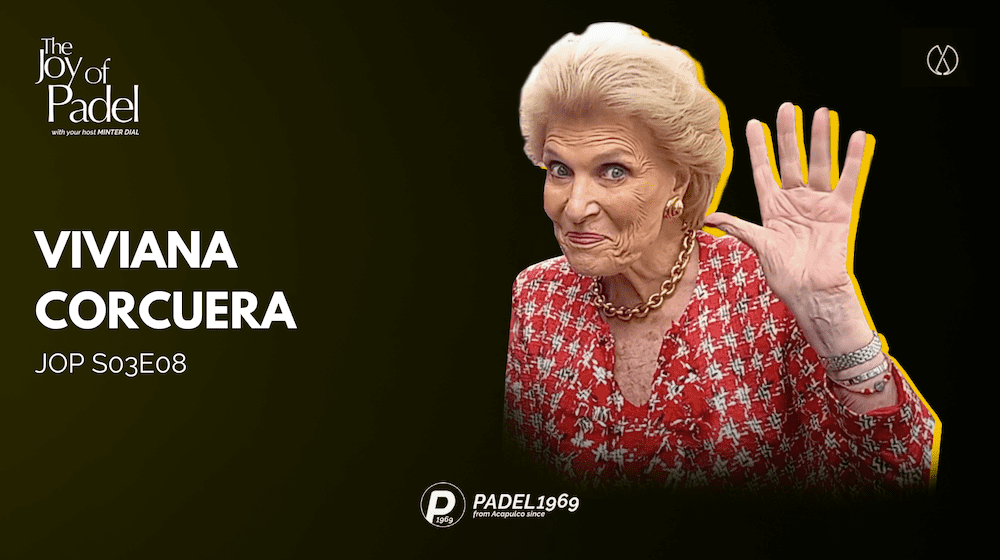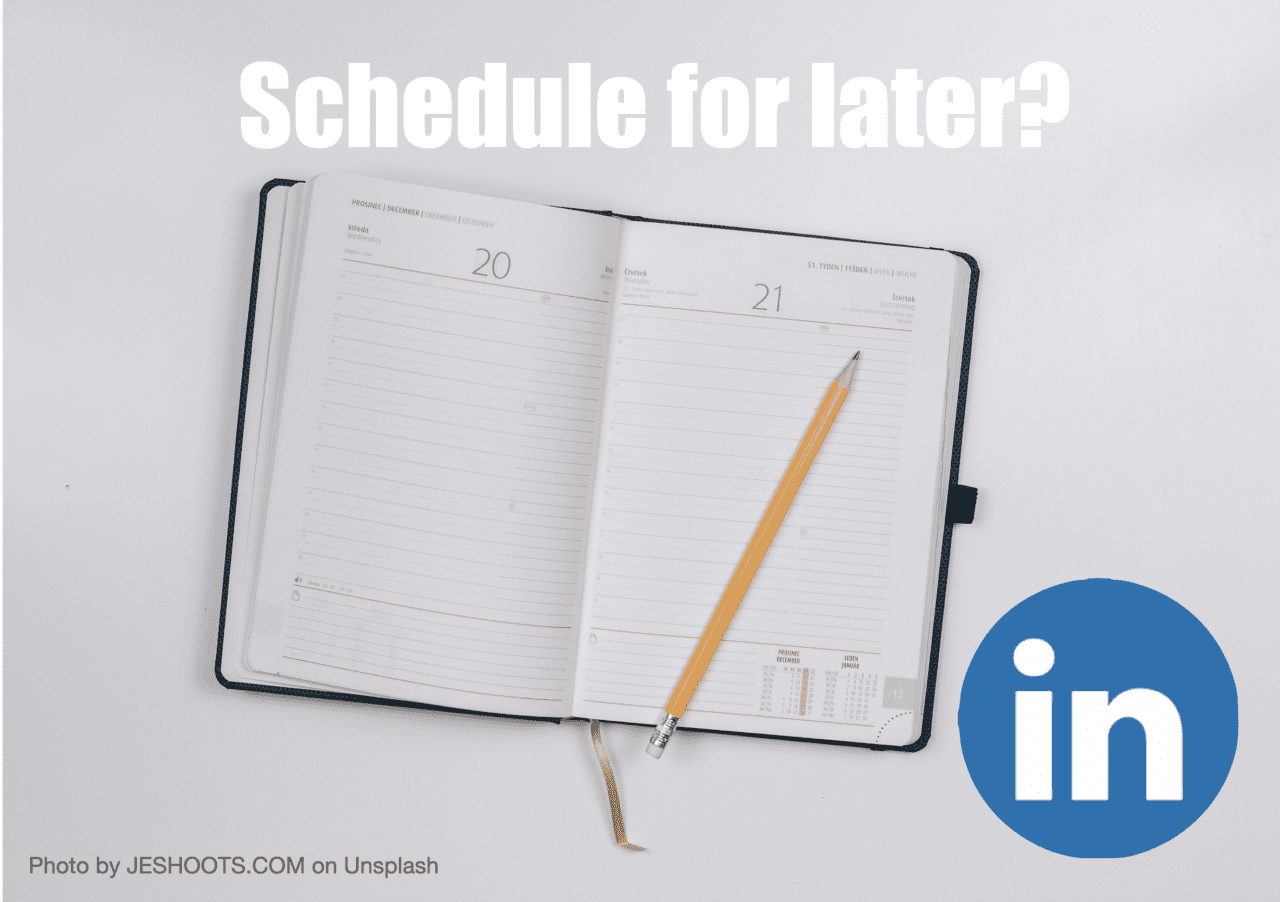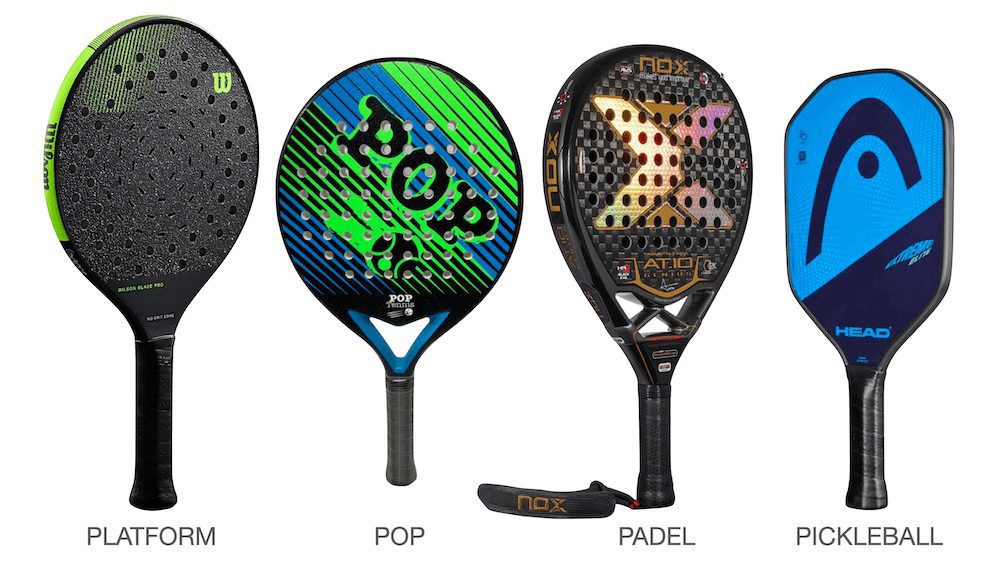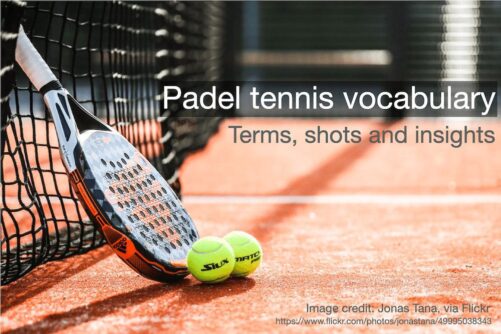The Joy of Padel podcast with Viviana Corcuera (JOPS03E08)
N.B. The recording is in Spanish, but I’ve put it up on Youtube with English subtitles here.
Viviana Corcuera, wife of Enrique Corcuera with whom she cofounded padel, shares the fascinating history of the sport since its beginnings in 1969. She recounts how the equipment evolved, from wooden rackets to modern rackets that allow for spectacular plays. Viviana highlights the intergenerational nature of padel and its ability to unite families. She recalls anecdotes with personalities like Henry Kissinger and describes the international expansion of the sport, especially in Argentina and Spain. She enthusiastically discusses the development of clubs in Mexico and the excitement of current tournaments. Viviana conveys her passion for padel, emphasizing its “circus-like” nature and its impact on society.
You can also listen to the audio below (in Spanish only, of course!).
To listen to the show:
To listen to The Joy of Padel podcast, you can use the embedded player above, or go find it on Spotify, Apple Podcasts or any number of other podcasting services listed here.
Send in your questions or reactions:
Please send me your questions — as an audio file if you’d like — to nminterdial@gmail.com. Otherwise, below, you’ll find the show notes and, of course, you are invited to comment. If you liked the podcast, please take a moment to review and/or rate it! ¡VAMOS!
Further resources for The Joy of Padel:

The Joy of Padel podcast is brought to you in association with Padel1969, who are proud to create one of the best padel product and service offerings in the world. Padel1969 believes in passion, joy, and integrity. We respect the DNA and roots of Padel – from Acapulco since 1969. To check all their full offer in padel courts, equipment and savoir faire, please go visit the Padel1969 site.
Meanwhile, you can find Minter's other Evergreen podcasts, entitled The Minter Dialogue Show (in English and French) in this podcast tab, on Spotify, Megaphone or via Apple Podcasts.
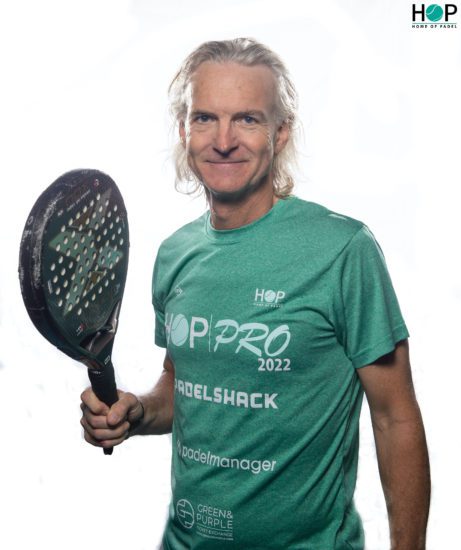
About the host: Minter Dial
Minter Dial is an international professional speaker, author & consultant on Leadership, Branding and Transformation. His involvement in sports has been a lifetime passion. Besides playing 18 years of rugby, captaining athletics teams, coaching tennis and playing squash for his university, he’s been a lifelong player of padel tennis, starting at the age of 10, from the time of its very first public courts at the Marbella Club in 1974.
Then, after a successful international career at L’Oréal, Minter Dial returned to his entrepreneurial roots and has spent the last twelve years helping senior management teams and Boards to adapt to the new exigencies of the digitally enhanced marketplace. He has worked with world-class organisations to help activate their brand strategies, and figure out how best to integrate new technologies, digital tools, devices and platforms. Above all, Minter works to catalyse a change in mindset and dial up transformation. Minter received his BA in Trilingual Literature from Yale University (1987) and gained his MBA at INSEAD, Fontainebleau (1993). He’s author of four award-winning books, including Heartificial Empathy 2nd edition (2023), You Lead (Kogan Page 2021), co-author of Futureproof (Pearson 2017); and author of The Last Ring Home (Myndset Press 2016), a book and documentary film, both of which have won awards and critical acclaim.
It’s easy to inquire about booking Minter Dial here.
Full transcript of interview via Flowsend.ai
This transcription (translated into English via Google Translate) comes courtesy of Flowsend.ai, an AI service for podcasters.
Minter Dial: Ms. Viviana Corcuera. What a pleasure. What would I have thought that I may have you as a guest on my Joy of Padel podcast? It’s an incredible privilege. Tell us in your own words how you wish to introduce yourself to our listeners.
Viviana Corcuera: Hello, I’m Viviana Corcuera, wife of inventor Enrique Corcuera. It was in 1968 [sic], in our house in Acapulco, that we built our first court. And you can see that padel became an international sport, but in five or six years, after ’68, so many Argentinians came to visit us because they were fascinated by the game, and little by little we started changing the rackets. Now, the rackets have an extraordinary ability to return the ball. Rackets are truly something wonderful. That’s the first, almost, but no.
Minter Dial: You can’t see it because the video doesn’t want to show it, but it’s true. Here’s the first racket I had which was in the 70s, 75s, something like that.
Viviana Corcuera: Well, here we have them all in a very nice museum.
Minter Dial: Where is the museum?
Viviana Corcuera: The museum is in the home of a great entrepreneur named Ignacio Soto Borja, a notary public whose office is in a neighborhood here in Mexico City, and there’s his museum. And he’s extraordinary in helping his father develop more and more around the world. We can arrange for you to do a major report on him and his museum. The remaining court in Mexico is his, the first one, because mine was destroyed when the house was sold. But the gentleman still has it—the most famous notary public in Mexico, Ignacio Soto Borja—still has the court in his home, and he made a museum with many Argentine rackets, with many photos of their clothing, of how we started playing pelota, how we started playing. He has everything in that museum, and it’s beautiful. I’d be happy to put you in touch with him.
Minter Dial: With pleasure. Please. I’d like to visit this museum. But at the beginning, since you were at the beginning of it all—I propose that you were a co-founder with your husband—but at the beginning, can you tell me the origins, how you grew from an idea to the reality of your first court?
Viviana Corcuera: Well, look, my first court was the one in Acapulco, as you know. Unfortunately, when Don Enrique died, we sold the house and the court was demolished. But we built an extraordinary court because my son Enrique Corcuera, who also has the same name as his father, sells courts, clothing, and rackets, everything related to his father. And we had the opportunity to build a court in the new building where we live now in Acapulco, but a beautiful, regulation-size, light blue, divine court. The truth is that we all enjoy playing and have a great time, because padel tennis creates a family atmosphere. You can play with your grandson, you with your son, with your grandfather; everyone can play within generations. And then you eat next to the court and talk afterward. It does a very nice thing: it brings the family together. People really like that.
Minter Dial: At first, I know the court was built, but at first there was no equipment, no racket. I understood that everything at the beginning was just tennis rackets. They cut the racket to play with almost half a tennis racket. At the beginning, it was already made of wood, as it has been since.
Viviana Corcuera: At first, they were made of wood. Because don’t forget there was a game called padel, and it was a padel, it was an open court played by children, and there was a very, very thin wooden racket, a very thin, very thin, wooden racket with little holes, but it wasn’t powerful because it was a game for children. They were made of wood with little holes, but millimetric, it was very, very narrow. Now, it’s impressive. I don’t know what’s inside them, but you’re amazed at the points you can make with the new rackets. They’re extraordinary, marvelous. And all the new points that have emerged, because the most spectacular is when the player hits the ball, the ball goes out, and the opponent goes out, puts it back into the court on the opposite side of the court, so much so that it’s an impressive thing. It’s like a wonderful circus show. And my children do very well at that, very well. And I love the championships we’ve seen around the world; it’s fascinating. The Spanish and Argentines are athletes, but they seem like they’re in a circus, the way they play.
Minter Dial: So, I understand that you are still looking at the professional father today.
Viviana Corcuera: Yes, of course, watching and playing. I play with all my friends. I have friends my age, 80, I have friends who are 60 and 50, and we all play together.
Minter Dial: So, as you said at the beginning about that family culture, intergenerational culture, it seems to me that there’s still a padel culture today. Do you see it? Do you see that special padel culture remaining?
Viviana Corcuera: What does it mean to say that there is a pad culture? You want to ask me, how is it?
Minter Dial: Custom, as there are behaviors, I don’t know how to say it, but people who play padel have a special attitude, instead of something about tennis or other sports, that there is something special, it.
Viviana Corcuera: What’s special about them is that they look like they’re from a circus.
Minter Dial: So, they always smile, you can’t believe it.
Viviana Corcuera: The way they come out, grab the ball from the outside, score, and score—you can’t believe it. It’s a circus show. At international championships, the number of people who come is impressive, the number of people who play padel in the country, the clubs there are in the country—all of them are impressive. We have a wonderful time with my father; we’re happy, honestly. And all my children play, and all my grandchildren play, we all play, all of us. Because we try to pair the older players with a younger player, and on the other side, another older player with a younger player. So, the game becomes very even.
Minter Dial: I’ve always been told by my professional communities that finding a partner on the court is similar to finding a partner in your personal life.
Viviana Corcuera: How lovely. Because it’s so special, especially when they’re playing on the same side, because if he goes, hey, if they go, if you go against him and he scores a goal, you don’t want to see it anymore. No, no, no, the truth is it’s very nice to play with our teammates whom we love very much, but here we play with everyone; there are a lot of us here, and we all take turns depending on our playing ability.
Minter Dial: I know your husband traveled to France and England, and it seems to have been important. How important were those trips to the development of padel?
Viviana Corcuera: Look, my husband, Enrique Corcuera, lived in France since he was a child. They lived in Paris, and his father sent him to school in England, at a wonderful school called Stony Hearst. He then sent them to the Normandie school in France. In both places, they played pelota paleta, and they played a game called padel. The padel court in Europe had no walls; there were no walls, not one at the back, not one on the sides, nothing. So, you had to go looking for the ball all the time, and it was horrible going to look for the ball because it was so cold at school, and you all had to go around the gardens looking for where the ball was. So, Viviana, he told me, let’s make a closed court because I’m not going to go looking for the ball.
Minter Dial: And that’s why it’s more and it worked out.
Viviana Corcuera: An impressive show, right?
Minter Dial: The ball is always next to it.
Viviana Corcuera: Neighbor, because always in the game, and for.
Minter Dial: That’s what we’re playing more than fetching the ball. So, in your entire life, having played so much, have you seen your father’s development, for example? I know my father played with Henry Kissinger.
Viviana Corcuera: In my house, in my house, in her house.
Minter Dial: But I suppose there were other interesting people, famous people, I don’t know. And maybe stories about those people who played the father. Do you have an interesting story about someone who still happens to you?
Viviana Corcuera: Henry Kissinger was President Nixon’s Secretary of State, and we saw him a lot socially in Mexico and Acapulco. He told us, “I know how to play tennis, but I’d love to play padel with you,” and his father became very good at it. But there was a big problem with him: he asked us to play at 8:00 a.m. in the early morning. And you can imagine that all the young people who came to play went to the nightclub, and the nightclub ended at 5:00 a.m. So, they came out of their rooms, exhausted, to play because they wanted to talk to Kissinger. Everyone wanted to say hello, everyone wanted to ask him questions, and the truth is that they enjoyed it a lot, they enjoyed it very, very much. He was charming, a charming man, a great player, a great conversationalist, a great Secretary of State under President Nixon.
Minter Dial: If you know what’s happening today, what you see, how society is doing, everything, do you think there’s a need for more padel in society? What else is missing?
Viviana Corcuera: It’s full of Clubs in México. You have no idea how many clubs there are in Mexico City and throughout the country. I’m going to hand out awards all the time. On weekends, I’m going to hand out awards for the wonderful courts there, for the wonderful entertainment you see, where they sell things, they sell beautiful, new outfits, you know, and where did this fashion come from? But they make very beautiful clothing, there are wonderful designers, and they all have stores in the clubs, and that’s very, very nice, very nice, we love it. Then there are good bars, there’s good food, there’s everything. I just went to Argentina. Well, in Argentina it’s a boom, but a very strong one, very strong. And they’re delighted to play, delighted. And since I’m Argentine, I’m very happy to go; I love Argentina.
Minter Dial: Are there any stories about why Argentina has such a strong padel scene? Because it developed in Argentina before Spain. I think in the 1980s, 1960s, 1970s, and 1980s, there were some.
Viviana Corcuera: I say it all started in ’68.
Minter Dial: And how was Argentina’s development?
Viviana Corcuera: Well, look, some players from Argentina who had tennis courts came to see us, and they were thrilled playing at my house. They were fascinated. They came in 1970, they were fascinated, they were fascinated. A friend of my husband, who had gone to school in England with him, was Argentine and his name was Julio Menditegui, who also passed away, like my husband. And Menditegui brought the court from my house and built it there. The first court was built by Mr. Julio Menditegui, a very elegant gentleman from Argentina, with some wonderful estates. And then you ask me in what other country, what other country did it develop like this? The US, in 1990, 91, 92, we went to women’s championships. I went to many, we played and we won. And it was wonderful. We had a very, very good time, very good time. I know we went to Houston, padel tennis is booming there. And we went, we went to what’s the name of this wonderful place we went to? We went to a place to inaugurate some courts, but it was on the outskirts of Marbella, because Marbella was where Prince Alfonso Hohenlohe spent all his November, December, and January vacations at my house in Acapulco. And since he loved the game, he was fascinated, he commissioned two padel courts to be built at the Marbella Club, the famous club he has, he’s since died, Alfonso the young man has died, but he had a club with wonderful, wonderful restaurants and a wonderful hotel. It was a magnificent family affair. His father was Prince Young Man and his mother was Mexican, Mrs. Iturbe, her name was Piedita Iturbe. That Mrs. Iturbe was Alfonso Johenlo’s mother. And Alfonso was German. And his father was a prince, and he was a prince too. And so, he built the Marbella Club. And we went to the inauguration and it was sensational. We had a lot of fun, we had a great time. And from that year onward, which was 1970, we went to Marbella, to his hotel, every year until my husband died. And we spent two months there. It was so much fun.
Minter Dial: You know Rudy, then? Count Rudy.
Viviana Corcuera: Charming Rudy. Adorable, adorable. I just saw him a few years ago, at Ira Fürstenberg’s 80th birthday. And he was with his charming wife, so sweet she is. I don’t know, I don’t know, what do I know? Rudy’s life is alive now, yes, I think.
Minter Dial: But I visited him three years ago. He seemed to be a beautiful man. So, I saw him at that time, but working, let’s say, less than before.
Viviana Corcuera: Well, the last time I saw him, he was very, very well. When he turned 80, Ira, who unfortunately just died, was it true? How sad. Ira de Fustenberg, Alfonso Hohenlohe’s wife, died. What else do you want to know?
Minter Dial: So, do you remember writing the rules of.
Viviana Corcuera: Paddle tennis, the padel tennis rules? I wrote the first rules of padel tennis because everything was a disaster. If the ball touched the tree, it had to be good and fall, and you had to catch it when it fell; it wasn’t very difficult. So, we had to cut down the trees so we could play without cheating, because the thing about it touching the tree and being good was really weird. But anyway, my husband got furious and said it’s good because the tree got in there and nobody got it in. The tree there, there’s its branches. No, no, how awful. Well, he was very nice. So, I made the rules in 1980. I made a very good set of rules that didn’t include the ball going out. That didn’t have that. The spectacle is wonderful. Better than anything you can see. There’s no better spectacle in the world than padel tennis, I think. Because tennis is much more peaceful. On the other hand, the father is like a circus performer.
Minter Dial: I agree with you 1000%. But the truth is that today there are more players playing padel than watching padel. Professionals prefer to play than watch. Now, even though it’s a spectacle, a circus, as you said, the professionals. The last question for you: being Argentine, you must be proud of how padel became so popular in Argentina and how the men, especially, continue to have incredible success in world championships. Do you follow what’s happening in terms of countries, the world championships?
Viviana Corcuera: Yes, I think the Argentine players are, and the same thing happens in football. Do you see how spectacular Messi is? He’s extraordinary. He’s out of this world. He’s an unparalleled person. And in padel, yes, we had two or three Argentine guys who were Gattiker. Do you remember Gatticer?
Minter Dial: Robbie Gattiker.
Viviana Corcuera: Robbie was a player, but he climbed over the fence, he came down, no, no, the way he played was spectacular. Very spectacular. I don’t know if he’s still playing. Do you think so?
Minter Dial: Yes, yes, yes. I played with him two years ago. But he’s much better than me.
Viviana Corcuera: Besides being a great player, he is friendly.
Minter Dial: I agree. I’ve done it, and I’ve invited you to my podcast before, in English. But do you follow the Argentine players today? Some, some. Among them, for example, Tapia or, I don’t know, Franco Stupaczuk, there are many Argentine players. Incredible.
Viviana Corcuera: I love the way you can pronounce the name of this Argentine Stupaczuk champion. What’s his name?
Minter Dial: Frank Stupaczuk. Agustín Tapia. But magic, magic, Viviana.
Viviana Corcuera: Incredibly difficult surnames.
Minter Dial: With my accent, worse too.
Viviana Corcuera: But look, it was a great pleasure talking to you. To those who watch our program, we send our warmest regards. And if you come to Mexico, be sure to look me up, because I’m truly delighted to show you the extraordinary courts we have here. There are some clubs that are truly a spectacle, because here there’s something called tequila. I mean, the championships end and the tequila begins. And everyone has a blast. They love it. So, we’re waiting for everyone here to watch our championships, to meet our fans, and to congratulate them for playing tennis.
Minter Dial: You have incredible energy. And you are very beautiful, very lovely. Thank you very much, Viviana.
Viviana Corcuera: Oh, how cute. Thank you. I love you so much.
Minter Dial: Me too. Thanks.
Viviana Corcuera: See you soon.
Minter Dial: See you later.

